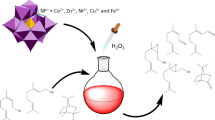Summary
-
1.
Contrary to the views of american workers, it has been shown that β-silicoalkyl halides may be used for the synthesis of silicohydrocarbons by the Grignard-Wurtz reaction; this is illustrated by the synthesis of 12 silicohydrocarbons, in yields of 20–50% (not counting a large number of syntheses with smaller yields).
-
2.
A mechanism is advanced for the so-called β-decomposition of β-silicoalkyl halides (R2Si-C-C-X). This consists of liberation of an olefin molecule, with attachment of the β-halogen atom to the silicon. The reaction may proceed spontaneously, at temperatures of from +50° to −50°, according to the structure of silicoalkyl halide, or it may be activated by the Grignard reagents. The Grignard reagents R°MgX react simultaneously both with the product of β-decomposition R2SiX and with the β-silicoalkyl halides, the yields of silicohydrocarbons (products of β-decomposition or of synthesis) varying widely according to the nature of R and R°.
-
3.
It is shown that the amount of β-decomposition fails in the series primary → secondary → tertiary silicoalkyl halides, and is greater for bromides that for chlorides. The radical R also affects the results, the yield of decomposition products falling, and of synthesis products rising, in the order C2H3, CH3, C2H6, C2H7, C4H2, i.e., in order of diminishing electronegativity of the radicals. The extent of β-decomposition could in some cases be reduced by conducting the syntheses at low temperature.
Similar content being viewed by others
Literature Cited
K.A. Kocheshkov, I.F. Lutsenko, and O.A. Reutov, Prog. Chem., 18, 497 (1949).
Das Gupta H. N. Y., Ind. Chem. Soc., 14 231 (1937); C.A. 7, 423 (1937).
S. N. Ushakov and A. M. Itenberg, J. Gen. Chem., 7, 2495 (1937).
L. H. Sommer, G. M. Goldberg, E. Dorfman, F. C. Whitmore, J. Am. Chem. Soc., 68, 1083 (1946). L. H. Sommer, D. L. Bailey, F. C. Whitmore, ibid 70, 2869 (1948).
L. H. Sommer, N. S. Marans, ibid, 72, 1935 (1950).
A. D. Petrov and V. F. Mironov, Proc. Acad. Sci. U.S.S.R., 75, 5 (1950), and 80, 5 (1951).
L. H. Sommer, F. C. Whitmore, J. Am. Chem. Soc. 68, 485 (1946).
L. H. Sommer, R. E. Van-Strein, F. C. Whitmore, ibid, 71, 3056 (1949).
L. H. Sommer, L. Y. Tyler, F. C. Whitmore, ibid, 70, 2872 (1948).
F. C. Whitmore, I. Sommer, ibid, 68, 475 (1946).
E. L. Warrick, ibid, 68, 2456 (1946).
Author information
Authors and Affiliations
Additional information
A lecture given at a general meeting of the Division of Chemical Sciences of the Academy of Sciences USSR, on March 28, 1952.




